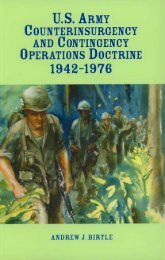C. Wiebes - Intelligence en de oorlog in Bosnië 1992-1995. De rol van de inlichtingen- en veiligheidsdiensten - Engels
C. Wiebes - Intelligence en de oorlog in Bosnië 1992-1995. De rol van de inlichtingen- en veiligheidsdiensten - Engels
C. Wiebes - Intelligence en de oorlog in Bosnië 1992-1995. De rol van de inlichtingen- en veiligheidsdiensten - Engels
- No tags were found...
You also want an ePaper? Increase the reach of your titles
YUMPU automatically turns print PDFs into web optimized ePapers that Google loves.
109They ma<strong>de</strong> civil and military risk analyses. Risk analysis was carried out <strong>in</strong> a strictly military fashion:<strong>De</strong>rks<strong>en</strong> was a Major <strong>in</strong> the commandos with his own platoon, and acted accord<strong>in</strong>gly.This team also established the basic structures for consultations with the NGOs, UnCivPol andUNMOs. They operated ‘with a blue cap on, us<strong>in</strong>g gre<strong>en</strong> methods’. Dutchbat II also boasted a goodliaison team. Contacts were <strong>in</strong>itiated, <strong>de</strong>veloped and ma<strong>in</strong>ta<strong>in</strong>ed. The objectives were as follows:escort<strong>in</strong>g convoys, monitor<strong>in</strong>g relief goods, fight<strong>in</strong>g corruption, and ma<strong>in</strong>ta<strong>in</strong><strong>in</strong>g contact with thepopulation. This team also functioned well and was giv<strong>en</strong> a pivotal <strong>rol</strong>e <strong>in</strong> the battalion. Collaborationwith the battalion comman<strong>de</strong>r was also good. 496The problems <strong>in</strong> this regard started with Dutchbat III. Accord<strong>in</strong>g to various MIS staff, the factthat Dutchbat III provi<strong>de</strong>d little tactical military <strong>in</strong>tellig<strong>en</strong>ce was a problem. As they saw it, Karremanstook the position that he was <strong>in</strong> charge of a UN unit, not a national one. The <strong>in</strong>tellig<strong>en</strong>ce officer wasconsi<strong>de</strong>red to be one of us. There was no structural report<strong>in</strong>g; 497 <strong>in</strong> his period as Head of the UNMOs,G<strong>en</strong>eral Gerard Bastiaans also turned aga<strong>in</strong>st supply<strong>in</strong>g <strong>in</strong>tellig<strong>en</strong>ce. No <strong>in</strong>tellig<strong>en</strong>ce was allowed to besupplied to the MIS/Army. Little or no response was ma<strong>de</strong> to specific or special questions from theMIS/Army. 498 It is strange <strong>in</strong> this regard that Karremans and Frank<strong>en</strong> ev<strong>en</strong> refused to go <strong>in</strong>to specificlogistics questions. In May 1995 the logistics section (<strong>in</strong> military terms: the G-4) of the RoyalNetherlands Army Crisis Staff was ev<strong>en</strong> forbidd<strong>en</strong> to gather logistics data. 499Dutchbat III did have its own <strong>in</strong>tellig<strong>en</strong>ce officer, Capta<strong>in</strong> E. Wieffer, but he reporte<strong>de</strong>xclusively to the Netherlands Army Crisis Staff, and not directly to the MIS/Army. This expla<strong>in</strong>s whyKarremans’ alarm<strong>in</strong>g letter (of 5 June) to the Army Crisis Staff did not become known to theMIS/Army until much later. 500 Wieffer s<strong>en</strong>t daily Situation Reports to Sector North East (SNE) andMilitary Information Summaries to the Army Crisis Staff. He was only able to make extremely limiteduse of the experi<strong>en</strong>ce of Dutchbat I and II dur<strong>in</strong>g the additional tra<strong>in</strong><strong>in</strong>g period <strong>in</strong> preparation for the<strong>de</strong>ploym<strong>en</strong>t of Dutchbat III. Wieffer conclu<strong>de</strong>d that the Army was no good at pass<strong>in</strong>g on experi<strong>en</strong>ces.As he saw it, the Army carried out <strong>de</strong>brief<strong>in</strong>gs, id<strong>en</strong>tified problems and discussed opportunities forimprovem<strong>en</strong>t, but oft<strong>en</strong> failed to carry th<strong>in</strong>gs through. As a consequ<strong>en</strong>ce, wh<strong>en</strong> evaluat<strong>in</strong>g a<strong>de</strong>ploym<strong>en</strong>t, the same <strong>de</strong>fects were observed as <strong>in</strong> the previous <strong>de</strong>ploym<strong>en</strong>t, but no solutions wereg<strong>en</strong>erated with a view to help<strong>in</strong>g the follow<strong>in</strong>g <strong>de</strong>ploym<strong>en</strong>t. 501Dutchbat III therefore took its own <strong>in</strong>itiatives. Dutchbat II soldiers on leave were <strong>in</strong>vited toAss<strong>en</strong> for a day to <strong>in</strong>form their successors of the activities and work<strong>in</strong>g conditions. The <strong>in</strong>itiative forthis was tak<strong>en</strong> by the battalion staff and from one company. In this respect, there was a significantdiffer<strong>en</strong>ce with Dutchbat I, which had be<strong>en</strong> unable to fall back on a pre<strong>de</strong>cessor. Dutchbat I wasor<strong>de</strong>red to optimise the <strong>in</strong>tellig<strong>en</strong>ce gather<strong>in</strong>g process on the situation <strong>in</strong> and around the <strong>en</strong>clave. Withregard to the military aspect, all the objectives and <strong>in</strong>t<strong>en</strong>tions of the warr<strong>in</strong>g factions at all levels had tobe id<strong>en</strong>tified. In terms of the humanitarian situation, the bor<strong>de</strong>rs of the areas conta<strong>in</strong><strong>in</strong>g ethnicm<strong>in</strong>orities, refugees and the homeless had to be <strong>de</strong>f<strong>in</strong>ed, with a view to supervis<strong>in</strong>g and protect<strong>in</strong>g theoccupants. Dutchbat I was also or<strong>de</strong>red to seek out accurate <strong>in</strong>formation on local needs with respect tofood, heat<strong>in</strong>g, shelter and medical assistance. This had to be passed on to UNHCR and BHC. 502An important part of the transfer of knowledge was formed by analysis of the situation <strong>in</strong> andaround Srebr<strong>en</strong>ica drawn up by Dutchbat I, and <strong>de</strong>veloped further by Dutchbat II. This docum<strong>en</strong>t wasalso used <strong>in</strong> the tra<strong>in</strong><strong>in</strong>g. 503 This meant that Dutchbat III did have good basic <strong>in</strong>formation at its496 MoD , Archive 101 MI S/ Cie , Van Jawad to Hakort, <strong>De</strong>brief<strong>in</strong>g report 101 MI S/Cie, 23/12/95.497 MoD, Archive SMG, 1004, report of a discussion with Col. Bokhov<strong>en</strong>, 20/07/95.498 Confid<strong>en</strong>tial <strong>in</strong>terviews (28 ) and ( 37).499 MoD, SMG, DocID 18428, File 530, Box 1004 , Interview with E. Otterloo on the logistics aspects of Dutchbat, 31/07/95.500 See for this letter: Chapter 8 of this study. In June, the Royal Netherlands Army Crisis Staff came to the follow<strong>in</strong>g conclusion: "Karremans is reach<strong>in</strong>g the <strong>en</strong>d of histether". This conclusion was drawn on the basis of his correspond<strong>en</strong>ce. Confid<strong>en</strong>tial <strong>in</strong>terview (23).501 Interview with E. Wieffer, 07/05/01.502 MoD , Archive MIS/Army 1994, Memorandum S2 BVT from Lmbl, May 1994.503 MoD, Archive MIS/Army 1994, File 1589, Zylab 13837 mil<strong>in</strong>fo Srebr<strong>en</strong>ica, October 1994.





